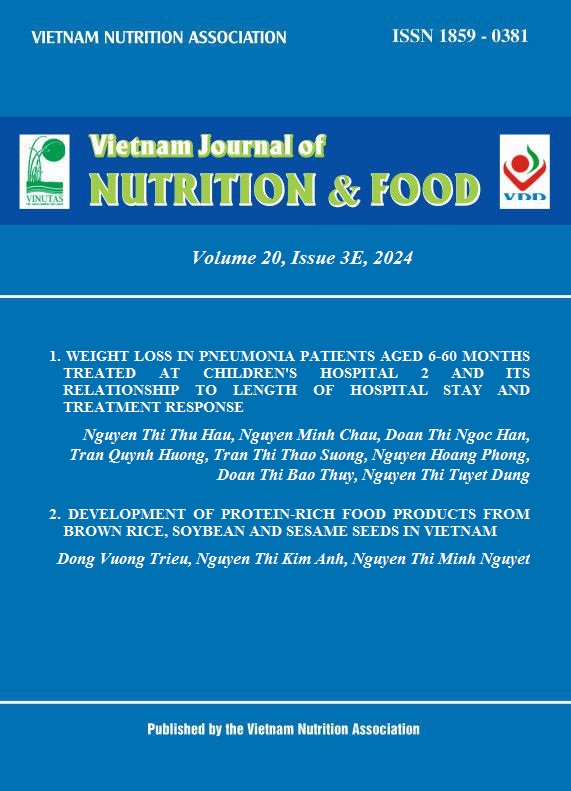CACHEXIA IN LUNG CANCER PATIENTS AT MILITARY HOSPITAL 103 AND SOME ASSOCIATED FACTORS
Nội dung chính của bài viết
Tóm tắt
Aims: The study aimed to evaluate the cachexia status and its associated factors in lung cancer patients.
Methods: The cross-sectional study was conducted on 97 lung cancer in patients at the Oncology Center, Military Hospital 103, between 2020 and 2021.
Results: The prevalence of cachexia in the lung cancer patients was 46.4%. In the multivariable regression models, the factors significantly associated with cachexia included age over 60 years (OR=3.3; p <0.05), nutrition impact symptoms (NIS) score (OR=1.26; p <0.01), and BMI <18.5 kg/m2 (OR=11.4; p <0.01). The NIS score demonstrated the best ability to screen for cachexia (AUC=0.715; p <0.001) in the lung cancer patients. Among the models combining factors for classifying cachexia, the Model consisted of 4 factors: NIS, BMI < 18.5 kg/m2, male gender, and age ≥ 60, yielding the best diagnostic value (AUC = 0.845; p < 0.001).
Conclusions: Malnutrition was common among lung cancer patients. Age, BMI, and NIS score were significantly associated with cachexia. The combination of the associated factors could improve the discrimination of cachexia in lung patients.
Từ khóa
Triệu chứng ảnh hưởng tới ăn uống, suy mòn, ung thư phổi, Bệnh viện Quân y 103
Chi tiết bài viết
Tài liệu tham khảo
2. Barajas Galindo DE, Vidal-Casariego A, Calleja-Fernandez A, et al. Appetite disorders in cancer patients: Impact on nutritional status and quality of life. Appetite. 2017;114: 23-27.
3. Sung H, Ferlay J, Siegel RL, Laversanne M, Soerjomataram I, Jemal A, Bray F. Global Cancer Statistics 2020: GLOBOCAN Estimates of Incidence and Mortality Worldwide for 36 Cancers in 185 Countries. CA Cancer J Clin. 2021;71(3):209-249. doi: 10.3322/caac.21660.
4. Zenke Y, Hakozaki T, Nakahara Y, et al. Medical management of older patients with lung cancer. Jpn J Clin Oncol. 2022;52(10): 1082-1088.
5. Kiss N. Nutrition support and dietary interventions for patients with lung cancer: current insights. Lung Cancer (Auckl). 2016; 7: 1-9.
6. Polanski J, Jankowska-Polanska B, Uchmanowicz I, et al., Malnutrition and Quality of Life in Patients with Non-Small-Cell Lung Cancer. Adv Exp Med Biol. 2017;1021: 15-26.
7. Liu CA, Liu T, Li HC, et al. Nutrition impact symptoms: Noteworthy prognostic indicators for lung cancer. Clin Nutr. 2023;42(4):550-558.
8. Nguyen Thi Mo, Vu Thi Quy, Ha Thu Thuy, et al. Nutritional status of lung cancers inpatients treated with combined chemotherapy and radiotherapy at the National Lung Hospital. Vietnam Journal of Medicine. 2024. 533(1):187-191.
9. Fearon K, Strasser F, Anker SD, et al., Definition and classification of cancer cachexia: an international consensus. Lancet Oncol, 2011. 12(5): 489-95.
10. Weir CB, Jan A. BMI Classification Percentile And Cut Off Points. 2023. In: StatPearls [Internet]. Treasure Island (FL): StatPearls Publishing; 2025. PMID: 31082114.
11. Jager-Wittenaar, H. and F.D. Ottery, Assessing nutritional status in cancer: role of the Patient-Generated Subjective Global Assessment. Curr Opin Clin Nutr Metab Care, 2017;20(5):322-329.
12. Omlin A, Blum D, Wierecky J, et al. Nutrition impact symptoms in advanced cancer patients: frequency and specific interventions, a case-control study. J Cachexia Sarcopenia Muscle; 2013. 4(1): 55-61.
13. Sheather S. A Modern Approach to Regression with R. Springer Texts in Statistics. 2009.
14. Muscaritoli M, Arends J, P. Bachmann, et al., ESPEN practical guideline: Clinical Nutrition in cancer. Clin Nutr. 2021;40(5): 2898-2913.
15. Arends J, Bachmann P, Baracos V, et al. ESPEN guidelines on nutrition in cancer patients. Clin Nutr. 2017;36(1):11-48.
16. Zhu, R., Z. Liu, R. Jiao, et al., Updates on the pathogenesis of advanced lung cancer-induced cachexia. Thorac Cancer, 2019;10(1): 8-16.
17. Chao PC and Lin CF. Successful early elemental diet nutritional support in an esophageal cancer patient. Journal of Cancer Research and Practice, 2017;4(2): 66-71.
18 Neoh MK, Abu Zaid Z, Mat Daud ZA, Md Yusop NB, Ibrahim Z, Abdul Rahman Z, Jamhuri N. Changes in Nutrition Impact Symptoms, Nutritional and Functional Status during Head and Neck Cancer Treatment. Nutrients. 2020;12(5):1225.doi: 10.3390/nu12051225.
19. Khorasanchi A, Nemani S, Pandey S, Del Fabbro E. Managing Nutrition Impact Symptoms in Cancer Cachexia: A Case Series and Mini Review. Front Nutr. 2022;9:831934. doi: 10.3389/fnut.2022.831934.
20. Findlay M, Bauer J, Shaw T, White K, Lai M, Rankin NM. "There's a lot of talent in the room but it's only really the medical talent that gets heard": a qualitative exploration of multidisciplinary clinicians' perspectives of optimal nutrition care of patients with head and neck cancer. Support Care Cancer. 2021;29(11):6399-6409. doi: 10.1007/s00520-021-06162-4.


